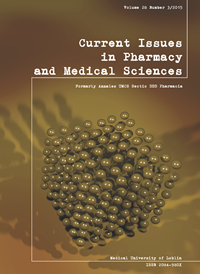Desloratadine analysis: as a pharmaceutical preparation and after accelerating ageing
DOI:
https://doi.org/10.1515/cipms-2015-0068Keywords:
desloratadine, densitometry, accelerating ageing, HPTLC, GC-MSAbstract
Desloratadine is a biologically active compound that is not described in the Polish Pharmacopoeia IX, hence, its study is particular important. The aim of this work was to establish a procedure for desloratadine analysis by way of HPTLC in combination with densitometry, so as to be able to ascertain its presence and degree of presence within pharmaceutical preparations. In our work, a mixture of ethyl acetate, n-butanol, ammonia and methanol was used as the mobile phase. Moreover, HPTLC plates pre-coated with silica gel 60F254 were also employed. The proposed method was tested and subsequently validated. Spectrodensitometric analysis was then performed to determine the optimal wavelength for the quantitative determination (λ=276 nm), and following this, a quantitative analysis of desloratadine within certain pharmaceutical preparations was performed. Our research also took into consideration an analysis of the products of desloratadine decomposition that come about as a result of the accelerated aging of its solutions. The employed procedure for accelerating the aging of such desloratadine solutions consisted of heating these at 40°C and then irradiating the solution surfaces with UV light. The changing color of these solutions after 2 hours of exposure served to indicate that degradation had occurred. Of note: as a result of irradiation with UV light, desloratadine content was seen to decrease with time, declining to almost zero after 30 hours. However, heating a solution of desloratadine alone did not induce a change in its content. Solutions of desloratadine that had previously undergone irradiation and heating were also analyzed to ascertain whether new substances were present. For this purpose, the GC-MS process was employed. As a result of this procedure, the spectrum of the solution after aging showed the presence of several new peaks that displayed retention several times larger and smaller than the normal desloratadine peak.
References
1. Caglar S., Oztunc A.: A sensitive spectrophotometric determination of desloratadine in tablets. J. AOAC Int., 90(2), 372, 2007.
2. Caglar S., Toker S.E.: Simultaneous determination of desloratadine and pseudoephedrine sulphate in tablets by high performance liquid chromatography and derivative spectrophotometry. Rev. Anal. Chem. 30, 145, 2011.
3. El-Enany N.M., El-Sherbiny D., Belal F.: Spectrophotometric, spectrofluorometric and HPLC determination of desloratadine in dosage form and human plasma. Chem. Pharm. Bull., 15(12), 1662, 2007.
4. Hasnain M.S. et al.: Development and validation of an improved LC-MS/MS method for the quantification of desloratadine and its metabolite in human plasma using deuterated desloratadine as internal standard. J. Pharm. BioAllied Sci. 5(1), 74, 2013.
5. http://www.tlcpharmachem.com/tlc_item.php?upc=L-1027&li= le_21&sub=L
6. ICH harmonized tripartite guideline: validation of analytical procedures: text and methodology, Q2 (R1), Geneva, 2005, http://www.ich.org Accessed 30 August 2013.
7. Mohamed G.G., Abou Attia F.M., Ibrahim N.S.: Development and validation of spectrophotometric and HPLC methods for the determination of desloratadine in tablets and syrup. J. Pharm. Res. 5(5), 2799, 2012.
8. Polish Farmacopeia IX, Polish Pharmaceutical Society, Warsaw, 2011
9. Ponnuru V.S, Challa B.R., Nadendla R.: Quantification of desloratadine in human plasma by LC-ESI-MS/MS and application to a pharmacokinetic study. J. Pharm. Anal. 2(3), 180, 2012.
10. Rele R.V., Gurav P.J.: A Simple extractive spectrophotometric determination of loratadine, desloratadine and rupatadine from pharmaceutical formulations. Int. J. Pharma Bio Sci. 3(2), 89, 2012.
11. Renger B., Vegh Z., Ferenczi-Fodor K.: Validation of thin layer and high performance thin layer chromatographic methods. J. Chromatogr. A, 1218, 2712, 2011.
12. Srinubabu G. et al.: Development and validation of high-throughput liquid chromatography–tandem mass spectrometric method for simultaneous quantification of loratadine and desloratadine in human plasma. J. Chromatogr. B, 860(2), 202, 2007.
13. Vlase L. et al.: Determination of loratadine and its active metabolite in human plasma by high- performance liquid chromatography with mass spectrometry detection. J. Pharm. Biomed. Anal. 44(3), 652, 2007.
14. Yang L.Y., Rudewicz P.J.: Application of new liquid chromatography – tandem mass spectrometry technologies for drug development support. J. Chromatogr. A, 926(1), 43, 2001.
Downloads
Published
Issue
Section
License
Copyright (c) 2015 Authors

This work is licensed under a Creative Commons Attribution-NonCommercial-NoDerivatives 3.0 Unported License.


